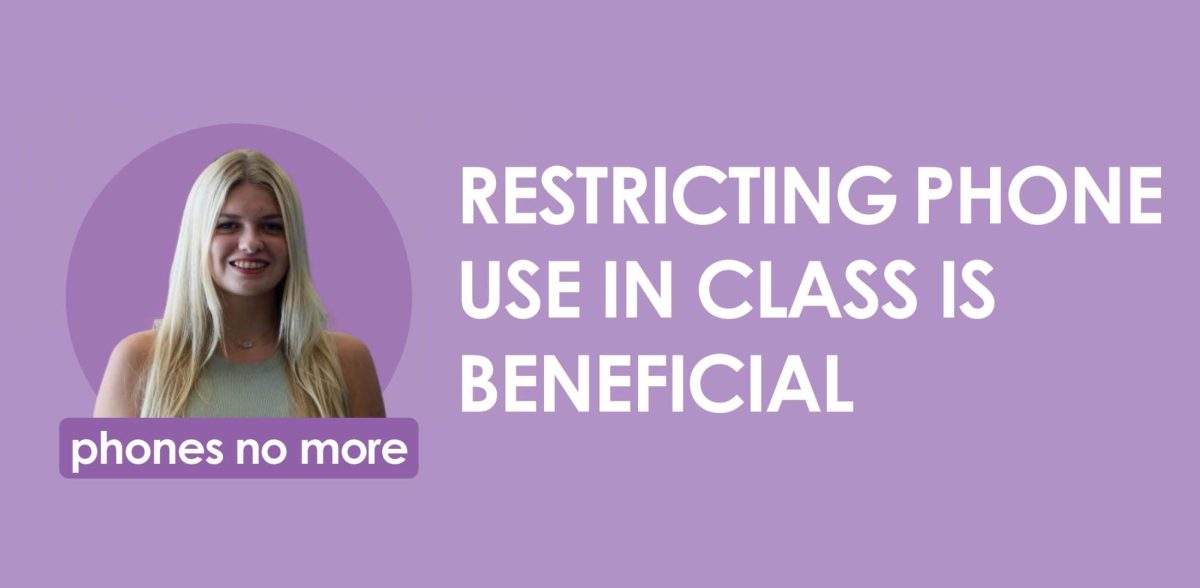In light of the recent Indiana cell phone ban, many students and teachers alike are wondering about the benefits and drawbacks of the law. Many students argue they need to have their cell phones on them to communicate with parents, while the policymakers passed the law on the basis that limited cell-phone access greatly improves test scores. In this case, the policymakers are right; students’ test scores increased greatly when cell phones were collected. In fact, they increased so much, it mimicked what the results would’ve been if an extra five days of school were added, according to the Journal of Labour Economics. This was especially true for already low-performing students, as they saw the greatest increase in test scores.
Students who argue they need their phones to communicate with their parents are ignoring a major flaw in their argument; for hundreds of years, parents have been unable to reach their children through a cell phone call. Our parents’ parents were unable to contact them through a cell phone call or text at school, and they have turned out just fine. Any truly serious issues parents may need to contact their children about can be run through student services first. Then, the school can call a student’s teacher and send them down to the office to speak with their parents in a more private setting. Parents will still have relatively easy access to their kids when they are at school, since students will still be able to check their phones at lunch and during passing periods.
The benefits of banning phones in classrooms don’t end at improved grades, however. It may also encourage students to take handwritten notes, which the Journal of Communication Education found to significantly improve grades. Students who were not looking at their phones in class recorded 62% more information in their notes and performed a letter grade and a half better compared to students who did use their phones in class on multiple choice tests. Taking good, detailed handwritten notes will also help prepare students for their college courses, which will be seriously more difficult than high school courses. Clearly, putting phones up in the classroom will have significant positive effects on high school students’ grades, present and future.
However, grades aren’t the only area that will benefit if students put up phones in classrooms. In fact, the Journal of Applied Economics found in a study conducted in Spain that putting up phones had not only a significant impact on grades, but on bullying as well. It found that bullying was greatly reduced. Incidents of bullying fell from 27.5% to 18%, a 9.5% reduction rate. With more time, it is likely that bullying incidents would fall even more, given cyberbullying is responsible for 20% of all bullying, according to Comparitech. Thus, implementing a phone ban in Indiana will likely have similar results. Life Smart Youth found 15.7% of Indiana high schoolers reported being victims of cyberbullying, and one in 20 will drop out of school due to bullying. A phone ban could limit this drop out rate and lower the cyberbullying rate.
Given the increased grades, better note taking and studying strategies and lowered bullying rate, it is impossible to deny the array of benefits banning phones in classrooms has. Students with better grades, better self esteem and better social skills are greatly more prepared for working life than their counterparts who spend time at school staring at their phones.
The views in this column do not necessarily reflect the views of the HiLite staff. Reach Katie Maurer at kmaurer@hilite.org.

































![AI in films like "The Brutalist" is convenient, but shouldn’t take priority [opinion]](https://hilite.org/wp-content/uploads/2025/02/catherine-cover-1200x471.jpg)









































![Review: “The Immortal Soul Salvage Yard:” A criminally underrated poetry collection [MUSE]](https://hilite.org/wp-content/uploads/2025/03/71cju6TvqmL._AC_UF10001000_QL80_.jpg)
![Review: "Dog Man" is Unapologetically Chaotic [MUSE]](https://hilite.org/wp-content/uploads/2025/03/dogman-1200x700.jpg)
![Review: "Ne Zha 2": The WeChat family reunion I didn’t know I needed [MUSE]](https://hilite.org/wp-content/uploads/2025/03/unnamed-4.png)
![Review in Print: Maripaz Villar brings a delightfully unique style to the world of WEBTOON [MUSE]](https://hilite.org/wp-content/uploads/2023/12/maripazcover-1200x960.jpg)
![Review: “The Sword of Kaigen” is a masterpiece [MUSE]](https://hilite.org/wp-content/uploads/2023/11/Screenshot-2023-11-26-201051.png)
![Review: Gateron Oil Kings, great linear switches, okay price [MUSE]](https://hilite.org/wp-content/uploads/2023/11/Screenshot-2023-11-26-200553.png)
![Review: “A Haunting in Venice” is a significant improvement from other Agatha Christie adaptations [MUSE]](https://hilite.org/wp-content/uploads/2023/11/e7ee2938a6d422669771bce6d8088521.jpg)
![Review: A Thanksgiving story from elementary school, still just as interesting [MUSE]](https://hilite.org/wp-content/uploads/2023/11/Screenshot-2023-11-26-195514-987x1200.png)
![Review: "When I Fly Towards You", cute, uplifting youth drama [MUSE]](https://hilite.org/wp-content/uploads/2023/09/When-I-Fly-Towards-You-Chinese-drama.png)
![Postcards from Muse: Hawaii Travel Diary [MUSE]](https://hilite.org/wp-content/uploads/2023/09/My-project-1-1200x1200.jpg)
![Review: "Ladybug & Cat Noir: The Movie," departure from original show [MUSE]](https://hilite.org/wp-content/uploads/2023/09/Ladybug__Cat_Noir_-_The_Movie_poster.jpg)
![Review in Print: "Hidden Love" is the cute, uplifting drama everyone needs [MUSE]](https://hilite.org/wp-content/uploads/2023/09/hiddenlovecover-e1693597208225-1030x1200.png)
![Review in Print: "Heartstopper" is the heartwarming queer romance we all need [MUSE]](https://hilite.org/wp-content/uploads/2023/08/museheartstoppercover-1200x654.png)




